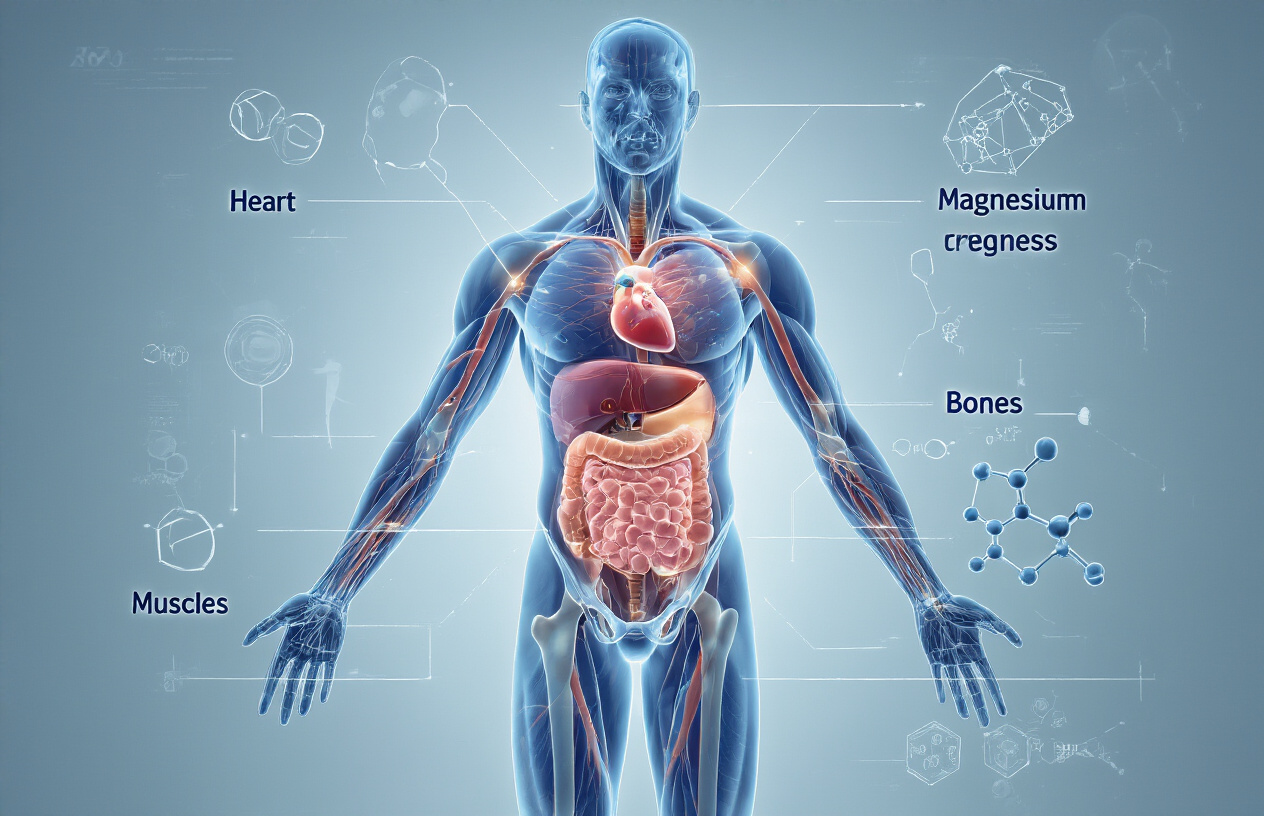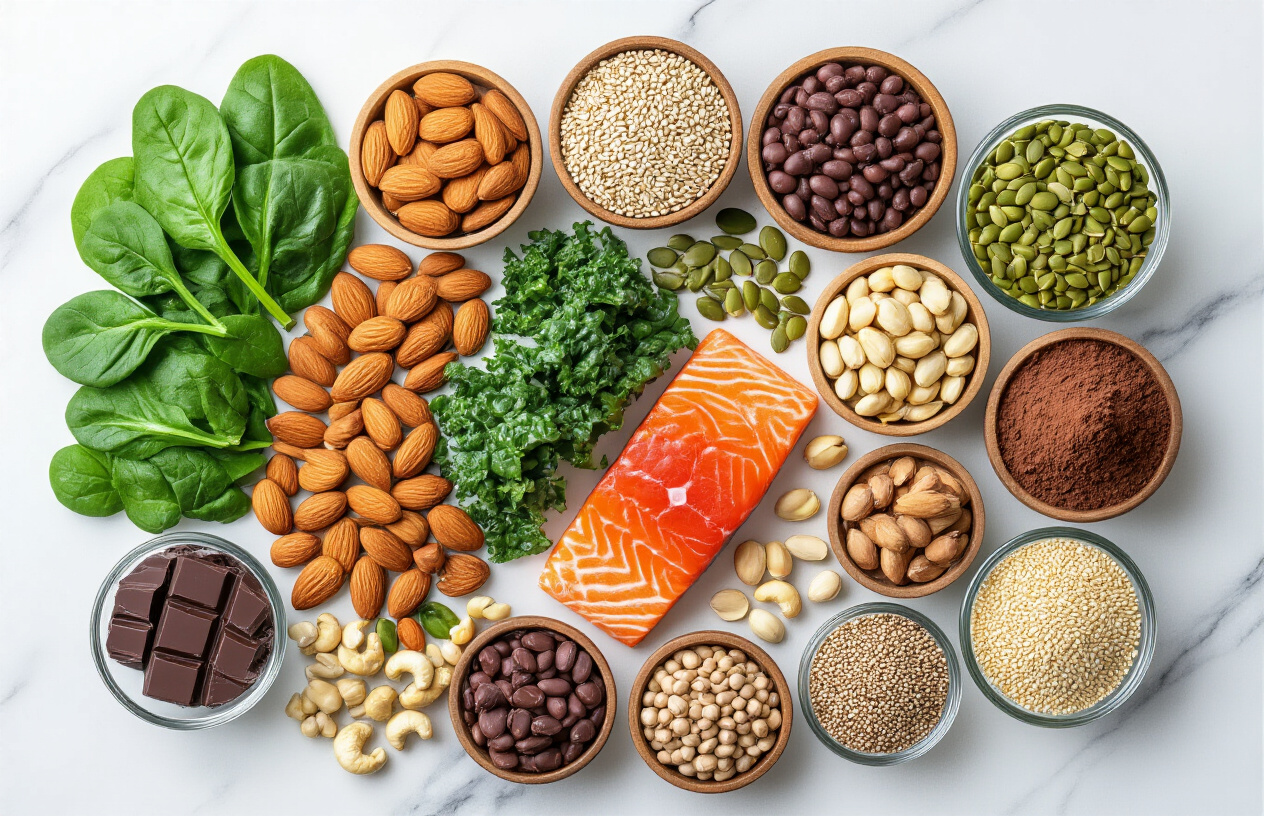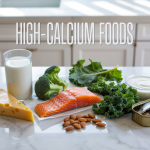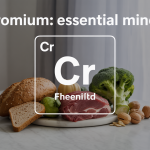Getting enough magnesium can be tricky when you don’t know which foods pack the biggest punch. This essential mineral keeps your muscles, bones, and heart healthy, but most people fall short of the daily recommended amount.
This guide is perfect for anyone wanting to boost their magnesium intake naturally through food choices. You’ll discover which leafy greens and nuts deliver the most magnesium per serving, plus learn simple ways to work these powerhouse foods into your daily meals without overhauling your entire diet.
We’ll cover the top high-magnesium foods across different categories and share practical tips for making magnesium-rich eating part of your routine.
Understanding Magnesium’s Essential Role in Your Body

Supports Strong Bones and Teeth Formation
Magnesium plays a crucial role in building and maintaining strong bones throughout your life. About 60% of your body’s magnesium is stored in your bones, where it works alongside calcium and vitamin D to create the mineral matrix that gives bones their strength and structure. Without adequate magnesium, your body can’t properly absorb calcium, making even the highest calcium intake less effective.
Your teeth also depend heavily on magnesium for their formation and ongoing health. This mineral helps regulate the calcium and phosphate balance needed to maintain tooth enamel, your teeth’s protective outer layer. People with magnesium deficiency often experience weaker tooth enamel and increased susceptibility to dental problems.
Research shows that magnesium deficiency can lead to reduced bone density and increased fracture risk. The mineral activates vitamin D, which is essential for calcium absorption in your intestines. When magnesium levels are low, vitamin D remains inactive, creating a cascade effect that compromises bone health even when calcium intake appears adequate.
Regulates Heart Rhythm and Blood Pressure
Your heart relies on magnesium to maintain its steady, rhythmic beat. This mineral acts as a natural calcium channel blocker, helping heart muscles relax between beats and preventing irregular heartbeats. Magnesium deficiency can lead to arrhythmias, palpitations, and other cardiac rhythm disturbances that affect millions of people worldwide.
Blood pressure regulation is another critical function of magnesium. The mineral helps blood vessels relax and dilate, reducing the resistance against which your heart must pump. Studies consistently show that people with higher magnesium intake tend to have lower blood pressure readings and reduced risk of hypertension.
Magnesium also supports healthy cholesterol levels and reduces inflammation in blood vessels. These effects combine to protect against cardiovascular disease, stroke, and heart attacks. The mineral’s ability to prevent calcium buildup in arteries helps maintain flexible, healthy blood vessels that can adapt to changing blood flow demands.
Boosts Energy Production and Metabolism
Every cell in your body needs magnesium to produce energy efficiently. This mineral is a cofactor for over 300 enzymatic reactions, many of which are directly involved in converting food into usable energy. Magnesium helps break down glucose, fats, and proteins, transforming them into ATP, your body’s primary energy currency.
Your mitochondria, the powerhouses of your cells, require magnesium to function optimally. These tiny structures generate the energy needed for everything from muscle contractions to brain function. When magnesium levels drop, mitochondrial efficiency decreases, leading to fatigue, weakness, and reduced physical performance.
Magnesium also regulates blood sugar levels by improving insulin sensitivity. This means your cells can more effectively take up glucose from your bloodstream, preventing energy crashes and maintaining steady energy levels throughout the day. People with adequate magnesium intake often report better stamina, improved exercise performance, and more consistent energy levels.
Enhances Muscle and Nerve Function
Proper muscle function depends on the delicate balance between magnesium and calcium. While calcium triggers muscle contractions, magnesium allows muscles to relax afterward. Without sufficient magnesium, muscles can remain in a contracted state, leading to cramps, spasms, and tension that many people experience, especially in their legs and feet.
Your nervous system uses magnesium to transmit signals between your brain and body. The mineral helps regulate neurotransmitters, the chemical messengers that carry information across nerve synapses. Adequate magnesium levels support clear thinking, emotional balance, and proper coordination between different parts of your nervous system.
Sleep quality also improves with optimal magnesium levels. The mineral helps activate the parasympathetic nervous system, which promotes relaxation and prepares your body for rest. Magnesium also regulates melatonin production, your body’s natural sleep hormone, making it easier to fall asleep and achieve deeper, more restorative sleep cycles.
Top Leafy Green Vegetables Rich in Magnesium

Spinach Delivers Maximum Magnesium Per Serving
Spinach stands out as the magnesium powerhouse among leafy greens, packing an impressive 157 milligrams per cooked cup. This dark leafy green delivers roughly 40% of your daily magnesium needs in a single serving. Raw spinach contains less concentrated amounts, but you’d need to eat significantly more volume to match the cooked version’s benefits.
The secret lies in how cooking breaks down spinach’s cellular structure, concentrating the mineral content while reducing the bulk. Baby spinach varieties contain similar magnesium levels but offer a milder taste for those new to leafy greens. Fresh spinach provides better magnesium absorption compared to frozen options, though both remain excellent choices.
Oxalates in spinach can interfere with magnesium absorption, but pairing spinach with vitamin C-rich foods like bell peppers or tomatoes helps counteract this effect. Adding a squeeze of lemon juice to your spinach dishes serves the same purpose while enhancing flavor.
Swiss Chard Provides Easy-to-Absorb Nutrients
Swiss chard offers 150 milligrams of magnesium per cooked cup while providing superior bioavailability compared to many other leafy greens. The rainbow-colored stems aren’t just pretty – they contain concentrated minerals, including magnesium, making them worth including in your meals rather than discarding.
This Mediterranean native has lower oxalate levels than spinach, meaning your body can absorb more of its magnesium content. The slightly bitter taste mellows beautifully when sautéed with garlic and olive oil, creating a side dish that actually tastes good while delivering serious nutritional value.
Red-stemmed varieties contain the same magnesium levels as their white and yellow counterparts, so choose based on visual preference. Swiss chard wilts down significantly when cooked, making it easy to consume large quantities without feeling overly full.
Kale Offers Multiple Health Benefits Beyond Magnesium
Kale provides approximately 23 milligrams of magnesium per cup when raw, or about 74 milligrams when cooked. While these numbers seem modest compared to spinach, kale’s magnesium works synergistically with its high vitamin K and calcium content to support bone health more effectively than magnesium alone.
Curly kale, lacinato kale, and red Russian varieties all contain similar magnesium levels, but their textures and flavors differ significantly. Massaging raw kale with a bit of olive oil and salt breaks down tough fibers, making the magnesium more accessible while improving taste and digestibility.
The sturdy leaves hold up well in smoothies, soups, and stir-fries without becoming mushy. Unlike more delicate greens, kale maintains its nutritional profile even after extended cooking times, making it perfect for slow-cooked dishes where you want sustained magnesium release.
| Leafy Green | Magnesium (mg per cooked cup) | Bioavailability | Best Preparation |
|---|---|---|---|
| Spinach | 157 | Moderate | Sautéed with lemon |
| Swiss Chard | 150 | High | Stems included |
| Kale | 74 | Good | Massaged or cooked |
Powerful Nuts and Seeds for Daily Magnesium Intake

Pumpkin Seeds Pack the Highest Magnesium Content
Pumpkin seeds stand out as the magnesium powerhouse in the nut and seed world. A single ounce delivers an impressive 168 milligrams of magnesium – nearly half of your daily requirement. These small green seeds, also known as pepitas, contain the highest concentration of bioavailable magnesium among all nuts and seeds.
The magnesium in pumpkin seeds comes in a highly absorbable form that your body can readily use for muscle function, nerve transmission, and energy production. Beyond magnesium, these seeds provide zinc, iron, and healthy fats that work synergistically to support immune function and heart health.
Raw pumpkin seeds offer the most nutritional bang, but lightly roasted varieties maintain most of their mineral content while adding a satisfying crunch. You can easily incorporate them into salads, yogurt, oatmeal, or enjoy them as a standalone snack.
Almonds Provide Sustained Energy and Heart Health
Almonds deliver 80 milligrams of magnesium per ounce, making them an excellent daily magnesium source. This mineral content works alongside almonds’ vitamin E, protein, and monounsaturated fats to create a nutritional profile that supports cardiovascular health and stable blood sugar levels.
The magnesium in almonds plays a key role in regulating blood pressure and maintaining healthy cholesterol levels. Research shows that people who regularly consume almonds tend to have better heart health markers and more stable energy throughout the day.
| Almond Form | Magnesium per Ounce | Best Uses |
|---|---|---|
| Raw whole almonds | 80mg | Snacking, trail mix |
| Almond butter | 87mg | Smoothies, toast |
| Sliced almonds | 75mg | Salads, baking |
Choose raw or dry-roasted almonds over those processed with oils and excess salt to maximize their nutritional benefits.
Cashews Support Brain Function and Bone Strength
Cashews provide 74 milligrams of magnesium per ounce, along with unique compounds that support brain health and cognitive function. The creamy texture and mild flavor make them incredibly versatile for both sweet and savory applications.
The magnesium in cashews works with other minerals like copper and phosphorus to maintain strong bones and support neurotransmitter production. This combination helps regulate mood, memory, and learning capacity while strengthening your skeletal system.
Cashews blend beautifully into smoothies, create rich dairy-free cream sauces, and work perfectly in stir-fries or curries. Their natural oils and proteins help slow digestion, providing steady energy release throughout the day.
Sunflower Seeds Offer Affordable Magnesium Source
Sunflower seeds pack 37 milligrams of magnesium per ounce at a fraction of the cost of tree nuts. These budget-friendly seeds make magnesium supplementation accessible to everyone while providing additional benefits like vitamin E and selenium.
The smaller magnesium content doesn’t diminish their value – sunflower seeds offer one of the most cost-effective ways to boost your daily intake. They’re also naturally free from common allergens, making them safe for people with nut allergies.
Hulled sunflower seeds work perfectly sprinkled over salads, mixed into granola, or eaten straight from the bag. The unhulled varieties provide extra fiber and minerals, though they require more effort to consume. Store them in airtight containers to prevent the natural oils from going rancid.
Whole Grains That Boost Your Magnesium Levels

Quinoa Delivers Complete Protein Plus Magnesium
Quinoa stands out as a nutritional powerhouse, packing approximately 118 milligrams of magnesium per cooked cup. This ancient grain, originally from South America, brings more to your plate than just magnesium – it’s one of the few plant foods that contains all nine essential amino acids, making it a complete protein source.
What makes quinoa special is how your body absorbs its nutrients. Unlike refined grains that lose most of their mineral content during processing, quinoa retains its natural magnesium levels because it’s consumed whole. The magnesium in quinoa works alongside its B vitamins and iron to support energy metabolism and muscle function.
Cooking quinoa is straightforward – rinse it well to remove the natural saponins that can taste bitter, then simmer with a 2:1 water-to-quinoa ratio for about 15 minutes. You can boost your magnesium intake by adding quinoa to salads, using it as a rice substitute, or incorporating it into breakfast bowls with nuts and seeds.
Brown Rice Supports Digestive Health and Energy
Brown rice contains about 84 milligrams of magnesium per cooked cup, significantly more than its white rice counterpart. The difference lies in the processing – brown rice keeps its bran and germ layers intact, where most of the magnesium resides.
The fiber in brown rice works hand-in-hand with its magnesium content to support digestive health. Magnesium helps relax the smooth muscles in your digestive tract, while the fiber promotes healthy gut bacteria growth. This combination makes brown rice an excellent choice for people dealing with digestive issues or those looking to maintain steady energy levels throughout the day.
Brown rice takes longer to cook than white rice – typically 45-50 minutes – but you can prepare larger batches and store them in the refrigerator for quick meals. Try mixing cooked brown rice with vegetables and a protein source for complete, magnesium-rich meals that keep you satisfied for hours.
Oats Provide Slow-Release Energy and Heart Benefits
Steel-cut oats deliver approximately 56 milligrams of magnesium per cooked cup, making them an excellent breakfast choice for boosting your daily magnesium intake. The magnesium in oats works alongside their beta-glucan fiber to support heart health and maintain stable blood sugar levels.
Oats release their energy slowly due to their complex carbohydrate structure and soluble fiber content. This slow-release mechanism helps prevent the energy crashes often associated with refined breakfast cereals. The magnesium in oats also supports the conversion of food into energy at the cellular level, making your morning fuel more efficient.
Steel-cut oats retain more of their natural magnesium compared to instant varieties because they undergo minimal processing. While they take 20-30 minutes to cook, you can prepare overnight oats by soaking rolled oats in milk or plant-based alternatives. Top your oats with magnesium-rich nuts, seeds, or dark chocolate for an even bigger mineral boost that tastes great and supports your health goals.
Fish and Seafood High in Bioavailable Magnesium

Mackerel Combines Omega-3s with High Magnesium
Mackerel stands out as a nutritional powerhouse, delivering approximately 97 mg of magnesium per 100-gram serving alongside its famous omega-3 fatty acids. This oily fish provides an exceptional dual benefit that supports both cardiovascular health and optimal muscle function. The magnesium in mackerel works synergistically with its omega-3 content to reduce inflammation and support healthy blood pressure levels.
Atlantic mackerel offers the highest magnesium concentration among mackerel varieties, while also being more affordable than many premium fish options. The bioavailability of magnesium from fish sources like mackerel is particularly impressive because animal proteins enhance mineral absorption in the digestive tract. Grilling, baking, or pan-searing mackerel preserves its magnesium content while creating delicious, flaky results.
Salmon Supports Heart Health and Brain Function
Wild-caught salmon provides roughly 95 mg of magnesium per 100 grams, making it an excellent choice for meeting daily magnesium requirements. The combination of magnesium, omega-3s, and high-quality protein creates a perfect storm of nutrients that support cognitive function and cardiovascular wellness.
Sockeye and King salmon varieties typically contain higher magnesium levels compared to farmed alternatives. The magnesium in salmon plays a crucial role in nerve transmission and muscle contraction, working alongside the fish’s B vitamins to support energy metabolism. Regular salmon consumption can help prevent magnesium deficiency while providing essential amino acids that support overall health.
| Salmon Type | Magnesium (per 100g) | Best Cooking Method |
|---|---|---|
| Wild Sockeye | 95-105 mg | Grilled or Baked |
| Atlantic Farmed | 85-92 mg | Pan-seared |
| Coho | 88-96 mg | Cedar plank grilled |
Halibut Provides Lean Protein and Essential Minerals
Halibut delivers approximately 91 mg of magnesium per 100-gram serving while remaining one of the leanest fish options available. This white fish offers exceptional protein quality with minimal fat content, making it perfect for those seeking magnesium-rich foods without excess calories.
Pacific halibut generally contains slightly more magnesium than Atlantic varieties, and its mild flavor makes it incredibly versatile in cooking applications. The magnesium in halibut supports bone health and helps regulate blood sugar levels, while its lean protein content aids in muscle maintenance and repair. Halibut’s firm texture holds up well to various cooking methods, from simple baking to more complex preparations.
Sardines Offer Budget-Friendly Magnesium and Calcium
Sardines pack an impressive 88 mg of magnesium per 100 grams while remaining one of the most economical seafood choices available. These small fish also provide substantial amounts of calcium, creating a mineral combination that’s particularly beneficial for bone health and muscle function.
Canned sardines retain their magnesium content exceptionally well, making them a convenient pantry staple for quick, nutritious meals. The bones in sardines are soft and edible, providing additional calcium that works alongside magnesium for optimal bone mineralization. Fresh sardines offer slightly higher magnesium levels, but canned varieties provide year-round availability and extended shelf life without significant nutrient loss.
- Fresh sardines: 90-95 mg magnesium per 100g
- Canned in water: 85-90 mg magnesium per 100g
- Canned in olive oil: 80-88 mg magnesium per 100g
Legumes and Beans for Plant-Based Magnesium

Black Beans Support Digestive Health and Energy
Black beans pack a powerful magnesium punch with approximately 120 milligrams per cup, making them one of the most magnesium-rich legumes you can add to your plate. These dark, nutrient-dense beans deliver about 30% of your daily magnesium needs while supporting your digestive system with an impressive 15 grams of fiber per serving.
The magnesium in black beans works alongside their high fiber content to promote healthy digestion and maintain steady energy levels throughout the day. This mineral helps relax smooth muscle tissue in your digestive tract, reducing cramping and supporting regular bowel movements. Black beans also contain complex carbohydrates that release glucose slowly into your bloodstream, preventing energy crashes.
Key nutritional benefits per cup of cooked black beans:
- 120mg magnesium (30% DV)
- 15g fiber
- 15g protein
- Folate, potassium, and iron
Black beans shine in Mexican dishes, soups, salads, and burger patties. Try them in a simple black bean and quinoa bowl topped with avocado, or blend them into a creamy dip with lime and cumin.
Lima Beans Provide Fiber and Steady Blood Sugar
Lima beans, often called butter beans, contain about 81 milligrams of magnesium per cup, along with substantial amounts of fiber and plant-based protein. These creamy, mild-flavored legumes offer a gentler introduction to bean consumption for those building up their tolerance to high-fiber foods.
The combination of magnesium, fiber, and complex carbohydrates in lima beans creates an ideal food for blood sugar management. Magnesium plays a crucial role in glucose metabolism and insulin sensitivity, while the beans’ fiber slows down sugar absorption. This dual action helps prevent blood sugar spikes and supports long-lasting energy.
Lima beans also provide significant amounts of folate, potassium, and manganese. Their creamy texture makes them perfect for purees, stews, and casseroles. You can find them fresh, frozen, or dried, with baby lima beans offering a more tender bite than their larger counterparts.
Chickpeas Offer Versatile Protein and Magnesium
Chickpeas deliver about 78 milligrams of magnesium per cup while providing exceptional versatility in the kitchen. These round, nutty-flavored legumes serve as protein powerhouses with 15 grams per serving, making them ideal for vegetarian and vegan diets.
The magnesium in chickpeas supports muscle function and bone health, working synergistically with their protein content to maintain lean muscle mass. Chickpeas also contain significant amounts of folate, which works with magnesium to support healthy red blood cell formation and energy metabolism.
Popular chickpea preparations:
- Roasted chickpeas as a crunchy snack
- Hummus for dips and spreads
- Added to curries and stews
- Ground into chickpea flour for baking
Canned chickpeas offer convenience, but dried varieties often provide higher mineral concentrations when properly soaked and cooked. Rinse canned varieties to reduce sodium content while preserving their magnesium levels.
Dark Chocolate and Cocoa for Delicious Magnesium

Choose 70% Dark Chocolate for Maximum Benefits
When you’re craving something sweet, dark chocolate with at least 70% cacao content delivers both satisfaction and serious magnesium benefits. A single ounce of quality dark chocolate provides around 64 milligrams of magnesium—that’s roughly 16% of your daily recommended intake. The key lies in choosing chocolate with higher cacao percentages, as the magnesium content increases with darker varieties.
Look for brands that clearly label their cacao percentage on the packaging. The sweet spot for both taste and nutrition falls between 70-85% cacao content. Beyond this range, the bitter flavors can become overwhelming for most people, while below 70%, you’re getting more sugar and less of the beneficial compounds.
Quality matters significantly when selecting your dark chocolate. Single-origin chocolates often contain higher mineral concentrations since they come from specific regions known for their nutrient-rich soil. Organic options also tend to have fewer processing chemicals that can interfere with mineral absorption.
Raw Cacao Powder Boosts Smoothies and Desserts
Raw cacao powder packs an even more impressive magnesium punch than processed dark chocolate. Two tablespoons contain approximately 52 milligrams of magnesium, plus you avoid the added sugars and fats found in chocolate bars. This pure form of cacao maintains all its natural minerals since it hasn’t been roasted at high temperatures.
Blend cacao powder into your morning smoothies with banana, spinach, and almond milk for a chocolate-flavored magnesium boost that doesn’t taste like you’re drinking vegetables. The natural sweetness of fruits balances cacao’s slight bitterness perfectly.
For desserts, cacao powder works beautifully in homemade energy balls, mixed with dates, nuts, and coconut. You can also create healthy chocolate puddings by blending it with avocado and maple syrup. These treats satisfy chocolate cravings while delivering meaningful amounts of magnesium.
Store your cacao powder in a cool, dry place away from direct sunlight to preserve its mineral content and prevent it from developing a stale taste.
Balances Mood While Meeting Magnesium Needs
Dark chocolate and cacao don’t just provide magnesium—they create a perfect storm of mood-enhancing compounds that work together beautifully. The magnesium helps regulate neurotransmitters that control mood and stress responses, while other compounds like phenylethylamine and anandamide trigger the release of feel-good chemicals in your brain.
This combination makes dark chocolate particularly effective for managing stress-related magnesium depletion. When you’re stressed, your body burns through magnesium faster than usual, creating a cycle where low magnesium leads to more stress, which depletes magnesium further. A small piece of quality dark chocolate can help break this cycle.
The timing of your chocolate consumption matters for mood benefits. Eating dark chocolate in the afternoon can provide a natural energy lift without the crash associated with sugary snacks. The magnesium helps stabilize blood sugar levels while the natural caffeine provides gentle alertness.
Research shows that people who eat dark chocolate regularly report better mood stability and lower stress levels. The key is moderation—one to two ounces per day provides substantial magnesium benefits without excessive calories.
Simple Ways to Incorporate Magnesium-Rich Foods Daily

Create Balanced Meal Plans with Multiple Sources
Building meals that naturally include several magnesium-rich foods doesn’t require complicated planning. Start with a foundation of leafy greens like spinach or Swiss chard, then add a protein source such as salmon, black beans, or tofu. Complete your plate with a whole grain like quinoa or brown rice, and you’ve already hit multiple magnesium sources in one meal.
Think about combining foods that work well together both nutritionally and flavor-wise. A breakfast bowl with oatmeal, chopped almonds, and dark chocolate chips gives you three different magnesium sources. For lunch, try a salad with mixed greens, pumpkin seeds, and grilled mackerel. Dinner could feature lentil curry over brown rice with a side of steamed broccoli.
| Meal | Magnesium Sources | Approximate Mg Content |
|---|---|---|
| Breakfast Bowl | Oatmeal, almonds, dark chocolate | 180-220mg |
| Green Salad | Spinach, pumpkin seeds, avocado | 150-190mg |
| Lentil Dinner | Lentils, brown rice, spinach | 200-240mg |
Plan your weekly meals around the seasonal availability of magnesium-rich produce. Summer offers plenty of fresh leafy greens, while fall brings nuts and seeds at their peak. Winter root vegetables like beets and sweet potatoes also contribute to your daily intake.
Smart Snacking Strategies for Consistent Intake
Smart snacking can bridge the gap between meals and keep your magnesium levels steady throughout the day. Keep a mix of raw almonds, cashews, and pumpkin seeds portioned in small containers for grab-and-go options. These provide sustained energy along with substantial magnesium content.
Dark chocolate makes an excellent afternoon snack when you need both magnesium and a mental boost. Choose varieties with at least 70% cacao content for maximum mineral benefit. Pair it with a handful of nuts for added protein and healthy fats.
Fresh fruit combinations work beautifully, too. Bananas with almond butter provide potassium and magnesium together, supporting both muscle function and heart health. Figs, whether fresh or dried, pack impressive amounts of magnesium and satisfy sweet cravings naturally.
Quick Magnesium Snack Ideas:
- Trail mix with pumpkin seeds, almonds, and dark chocolate chunks
- Apple slices with cashew butter
- Roasted chickpeas seasoned with sea salt
- Greek yogurt topped with hemp seeds and berries
- Homemade energy balls made with dates, almonds, and cocoa powder
Keep these snacks visible and easily accessible. When healthy options are convenient, you’re more likely to reach for them instead of processed alternatives that offer little nutritional value.
Cooking Methods That Preserve Magnesium Content
The way you prepare magnesium-rich foods significantly affects how much of this vital mineral you actually absorb. Water-soluble minerals like magnesium can leach out during certain cooking processes, so choosing the right methods matters.
Steaming vegetables preserves more magnesium than boiling since the minerals don’t dissolve into the cooking water that gets discarded. When you do boil vegetables, save the cooking liquid for soups or smoothies to capture those nutrients. Quick sautéing with minimal liquid also helps retain mineral content while adding flavor.
Raw preparation works wonderfully for many magnesium sources. Leafy greens in salads, raw nuts and seeds, and fresh fruits maintain their full mineral profile. Sprouting legumes and grains actually increases their magnesium bioavailability compared to their dry counterparts.
Magnesium-Preserving Cooking Tips:
- Steam rather than boil leafy greens
- Roast nuts and seeds lightly to enhance flavor without nutrient loss
- Use minimal water when cooking grains
- Add sea salt or lemon juice to enhance mineral absorption
- Avoid peeling vegetables when possible – skins often contain concentrated minerals
Slow cooking methods like braising work well for tougher greens like kale or collards, breaking down fiber while keeping nutrients intact. Pressure cooking actually helps make minerals in legumes more available for absorption while dramatically reducing cooking time.
Soaking nuts, seeds, and grains before cooking removes natural compounds that can interfere with mineral absorption, making the magnesium more bioavailable to your body.

Getting enough magnesium doesn’t have to be complicated or boring. From crunchy almonds and pumpkin seeds to rich dark chocolate and hearty black beans, there are plenty of delicious ways to meet your daily needs. Leafy greens like spinach pack a serious magnesium punch, while whole grains and fatty fish offer tasty options that fit into any meal plan. The best part? You can easily mix and match these foods throughout your day.
Start small by adding a handful of nuts to your morning oatmeal or tossing some extra spinach into your lunch salad. Your muscles, heart, and energy levels will thank you for making these simple swaps. Remember, the goal isn’t perfection – it’s about making better choices more often. Pick a few magnesium-rich foods you actually enjoy eating and build from there.













